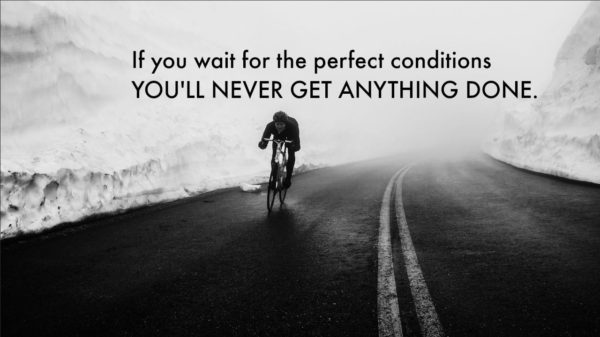Unfortunately, it’s that time of year again (for those of us that live in the Northern Hemisphere anyways). The trees are bare, the temperature is dropping, and snow is already creeping down the mountains. Although this may spell the end of days spent on the beach, it doesn’t have to end your cycling season. Here’s what you need to know about winter cycling.
Your Guide to Winter Cycling
Set your goals now
Now is the best time to start setting some goals, and making a plan to get to those goals. Going into the dark, cold season without a plan is a sure way to default to hibernation and way too much Netflix. Think about your goals for next year, where do you want to be at the beginning of next season. Be realistic with what you can actually accomplish over the winter (maybe don’t commit to riding 5 days a week), and focus on some cross training that will, in turn, make you stronger on your bike. Think of winter cycling as your base training, which is general conditioning rather than working on things like speed or endurance.
Layers, layers, and more layers
Staying warm on your bike is absolutely key to winter cycling. If you’re not dressed properly, not only are your muscles going to feel terrible, but it will make you never want to go outside again. In order of importance, think of your head, hands, feet and torso. Most heat escapes through your head, so wearing something like a balaclava under your helmet can be a great way to keep that heat in. Next, you’ll need proper winter cycling gloves that are warm enough, but also allow to steer and shift safely. Some thermal socks are great, as well as thermal shoe covers to keep your toes nice and cozy! Next up, keeping your torso warm is so important. The arms and legs don’t matter as much if your core temperature is nice and warm. Think lots of layers with a jacket that is both water and wind resistant.
Warm Up First
You never want to start your ride feeling chilled or cold. It will take a lot longer to raise your body temperature and get your blood pumping to your extremities. So, do a quick warm up inside before heading out, do some jumping jacks, burpees, or run in place.
Supplement with indoor riding or training
There will be some days that are just too ugly to ride outside, so no need to try be a hero. Having a setup with an indoor trainer can be great for those days. Almost all competitive cyclists will have an indoor setup to maintain high intensity workouts over the winter, as those can just be too tough to try to do out in the elements. If you’re a casual cyclist and don’t want to invest just yet, you can do some focused cross training in the form of swimming, cross country skiing, and strength training to keep up your fitness level.
Take care of your bike
Having a mechanical issue in the warmer months of the year can be inconvenient, but during the winter months it can spell disaster. Avoiding situations before they arise is the best solution, so getting your bike winter ready and starting with fresh parts will ensure they last until spring and beyond. This includes a thorough check over of the chain, brake pads, cables/housing, and tires. You may also want to make some additions in the form of fenders, lights and reflectors , and always carry a chain tool and spare tubes.
 Plan your route (and be realistic)
Plan your route (and be realistic)
It’s always a good idea to have at least a rough plan of your route no matter what the season, but it’s especially important in the winter. You don’t want to get stuck in an area there is construction or lots of debris on the road. You’ll also want to plan a shorter route than you may usually, that way you won’t get caught out of energy and cold too far from home. You can always add on depending on how you’re feeling.
Don’t try to be a hero
Some days are just no good to be out on your bike, and that’s okay. If you ride over the winter at all, then you’re already a hero, so you have nothing to prove. If it’s super windy, icy, or the middle of a blizzard, just don’t ride. Better to supplement with an indoor training day than risk riding in dangerous conditions.
